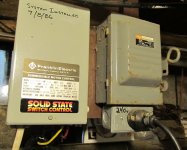Ok, so water is on. Started pulling at 9 am, finished at 4 pm. 1.5 hours going to Lowe's for pump. 30 min to Ace for rope; 30 min too Ace for 1-1/4" to 1" reducer bushing; 30 min back to Ace for some 1" coupling; some 90's.
Few observations: I sure hope those water proof butt splices are really water proof...
I pulled all 100 ft of 1" PVC riser as a single piece (it's thread sch-80 white pvc). Wasn't too bad to pull; but needed wife to walk the end back when I got around half out.
Old pump (.7 hp, 15 gpm) has smaller outside diameter then new one (3/4 hp, 10 gpm) and for some reason didn't sit as low in the casing as the old one. Kinda wonder is the old smaller diameter was in silt and sand, and new one set on top of that? It was most definitely sitting onb bottom... hope this doesn't come back to bite me in the butt, or at least doesn't for a long time. I've always had issues with sand and sediment in the well.
As a general question; what does the bottom of the casing look like. Obviously the casing is a 4" pvc pipe, probably basic DWV sch-40; but does the bottom just sit on the native sand, or is there a 4" well point on the bottom; or a piece with slits like a french drain?
Edit: actual pulling was about 15 minutes, and changing pump was maybe 30; had to do a lot of calling around, 2 TSC's, 2 Aces Hardware, Home Depot, and 2 Lowes'.
Re-edit: $369 plus tax for pump, $5.99 for water proof splices (baught two packs, just in case), 1-1/4" to 1" galvanized reducer bushing (could get one out of old pump) $5; pipe dope $5; 100 ft 1/4" nylon rope $9.99; 2 ea 1" 90' and 2 1" couplings at like $0.69 each.
Prices I got on phone; "$1,000 best case" and $950 plus $1/lf.
